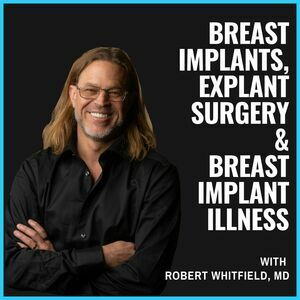Episode 70
Unlocking the Secrets of Stem Cells: Revolutionizing Breast Implants and Beyond
June 13th, 2024
15 mins 35 secs
Your Hosts
Tags
About this Episode
Over the years, stem cells have gained significant attention for their remarkable ability to transform into various cell types, presenting immense potential for regenerative medicine and treatment for a wide range of diseases. This growing interest has been driven by a series of groundbreaking discoveries and significant advancements in stem cell research. In the context of breast implants and breast implant illness, stem cells offer promising solutions for tissue regeneration and recovery, providing new hope for those seeking alternative treatments.
Whether you're curious about the science behind stem cells or considering a procedure involving fat transfer, this episode is packed with valuable insights to guide you on your journey to better health and wellness. Let’s explore more about how stem cells are transforming the medical field, providing new avenues for treatment and recovery. We'll dive into valuable insights and the latest advancements, helping you understand the incredible potential of stem cells and their benefits.
Fat transfer surgery for breast augmentation and reconstruction
I’ve recently attended several notable conferences where I gained valuable insights and innovations that I’m eager to integrate into our clinic. Some of these advancements include the incorporation of more lymphatic massage techniques, the introduction of NanoVi technology to improve protein folding and recovery, and the use of H-Wave therapy to further enhance lymphatic drainage and aid in patient recovery.
For today, however, let’s focus on fat transfers. Drawing from my extensive experience with fat transfers, a technique I’ve refined over many years, I explain that fat transfers are effective because they use the patient’s own tissue, making them autologous and thus free from the risks associated with donor tissues, such as genetic mismatches.
Fat transfers are versatile, as adipose-derived stem cells can differentiate into fat cells, bone cells, or cartilage, providing a range of benefits. My initial interest in this technique stemmed from a personal desire to regenerate cartilage in my knees after multiple surgeries, leading to a deep understanding of the procedure’s potential.
With extensive experience in sarcoma reconstruction, I can confidently say that fat transfers are safe when performed correctly. It's essential not to transfer fat to areas with existing tumors or sarcomas, as these mesenchymal regions could complicate the procedure.
For breast augmentation and reconstruction, fat transfers have been effective for many years, and I have conducted numerous procedures since 2005. Successful outcomes depend on transferring a mixture of adipocytes, vascular cells, and adipose-derived stem cells. This technique requires precise placement of fat in specific areas to avoid complications and ensure proper integration with the surrounding tissue.
There were early safety concerns regarding fat transfers for cosmetic purposes, such as buttock augmentation, due to technical issues when the procedure first gained popularity in South America and Miami. However, with advancements in techniques and improved safety measures, fat transfers for both buttock and breast augmentation have become reliable and effective procedures.
Fat transfer for breast implant illness, including stem cells and healing
When the skin gets really tense, you'll notice a condition called "peau d'orange," where the surface of the skin starts to look like the surface of an orange. This indicates too much pressure and that expansion should stop. Unlike implants, which can hold their shape and maintain more volume, fat cannot be continuously added. The amount of fat that can be added depends on the initial condition of the skin. For younger clients with tight skin, multiple sessions may be needed to gradually increase volume.
In cases where I remove implants that have been in place for a long time, often after weight changes, pregnancies, or breastfeeding, the skin is usually stretched out. After removing the implant with its capsular material intact, I don't fill the old implant pocket and instead, place the fat beneath the skin, where it belongs, and let it heal.
Adipose-derived stem cells in the fat offer numerous benefits, aiding in wound rejuvenation and healing. They can help turn genes on, produce exosomes, modulate immune responses, and improve mitochondrial function. This is why fat transfers are more than just about the fat itself – they bring substantial healing properties.
To maintain the results over time, factors like diet, detoxification ability, and gut health are crucial. We strongly advocate for fat transfers, leveraging the healing power of stem cells. We also offer stem cell harvesting and banking, a process I personally undergo every three to six months. Using our cell surgical device and extensive experience since 1998, we continually strive to enhance our offerings and improve patient outcomes.
We offer a variety of wellness products and supplies to help you on your recovery journey. So make sure to check out our online store at https://drrobssolutions.myshopify.com/ for extra resources and support. Browse our collection today to find everything you need for a healthier, more vibrant you!
Links and Resurces
Dr. Robert Whitfield’s Website
For any inquiries or concerns, feel free to connect with us on Instagram (@breastimplantillnessexpert).
https://www.instagram.com/drrobertwhitfield/
For more information on Virtual and In Person Consultations, we always answer our messenger personally:
https://www.drrobertwhitfield.com/contact/
Try the Echo Hydrogen Water Bottle
Code is DRROB10.
Let’s Connect...
Podcast: https://podcasts.apple.com/gb/podcast/breast-implant-illness/id1678143554
Spotify: https://open.spotify.com/show/1SPDripbluZKYsC0rwrBdb?si=23ea2cd9f6734667
TikTok: https://www.tiktok.com/@drrobertwhitfield?_t=8oQyjO25X5i&_r=1
IG: https://www.instagram.com/breastimplantillnessexpert/
FB: https://www.facebook.com/DrRobertWhitfield
Linkedin: https://www.linkedin.com/in/dr-robert-whitfield-md-50775b10/
X: https://x.com/rob_whitfieldmd
Read this article - https://www.breastcancer.org/treatment/surgery/breast-reconstruction/types/implant-reconstruction/illness/breast-implant-illness
Shop: https://drrobssolutions.com
SHARP: https://www.harp.health
NVISN Labs - https://nvisnlabs.com/
Get access to Dr. Rob's Favorite Products below:
Danger Coffee - Use our link for mold free coffee - https://dangercoffee.com/pages/mold-free-coffee?ref=ztvhyjg
JASPR Air Purifier - Use code DRROB for the Jaspr Air Purifier - https://jaspr.co/
Echo Water - Get high quality water with our code DRROB10 - https://echowater.com/
BallancerPro - Use code DRROBVIP for the world's leader in lymphatic drainage technology - https://ballancerpro.com
Ultrahuman - Use code WHITFIELD10 for the most accurate wearable - https://www.ultrahuman.com/ring/buy/us/?affiliateCode=drwhitfield
